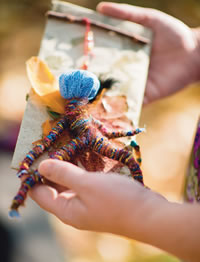Sharing Your Story


Photo by Edda Pacifico
Creative ways to document your personal experiences
Sandy Hackett's life was just getting back to normal after the death of her father from pancreatic cancer a few years earlier when she discovered a lump in her breast. With a diagnosis of breast cancer, the last thing she wanted was for her kids, then 3 and 9, to worry about a similar outcome.
An administrative assistant and office manager at the U-M Rogel Cancer Center, Hackett was familiar with available therapies that complement standard medical treatment. She continued working during her six months of treatment and made time for art therapy.
She also took materials home so her older son could express his feelings through art.
"We talked about the cancer," Hackett says. "We made little woven bags. I told him mommy made them, too, during her treatment."
For Hackett and her son, art therapy provided an emotional release. She remembers one project where she had to draw faces to depict how she felt. One face was happy, as she put on a happy face at work to maintain normalcy. The other face was screaming.
After receiving chemotherapy, radiation and five surgeries, Hackett has remained cancer-free for four years. She rarely spoke about her cancer.
Then she was invited to attend a workshop called Digital Storytelling: Everyday Stories by Cancer Patients and Survivors, the latest addition to the complementary therapies program offered by Legacy Therapist Sibel Ozer.
In addition to creating opportunities for expression, emotional or otherwise, the legacy program leaves each patient with a finished product that gives meaning to their experiences.
"We don't want legacy work to connote the end of life because it is not limited to that," Ozer says. "We can work with patients at any stage of a diagnosis or prognosis. We use legacy activities involving life review, storytelling and reminiscence for healing purposes."
Ozer and other complementary therapists from the Rogel Cancer Center's PsychOncology Program have done legacy work with patients in a variety of settings. The team is collectively working to establish how it can be made available in the future to more patients—from those in the infusion chair to the PsychOncology Clinic to three-day workshops.
Hackett recently attended one of Ozer's three-day workshops, which involved writing a story about something important to her, recording the story in her own voice, and combining the story with images, photos and music at the U-M Duderstadt Center.
Hackett wrote three stories going into the workshop and chose one to bring to the group. With the group's input, it was edited into her final digital story, which focused on how she continued working during the time she had cancer.
"The workshop was very intense. It was the most I cried. I felt a release of finally getting it out," she says. "Watching the final product was quite overpowering. It made it worth it."
Hackett says her kids, now 7 and 13, understand their mom is on the road to recovery. After attending the legacy workshop, she wants her kids to understand there are different ways to express emotion. Sometimes it's just a matter of finding the right medium.
Legacy therapy and other therapies of the PsychOncology Program are funded through the generosity of donors. Learn how you can support these programs on our Make a Gift webpage. Visit the Legacy Program web page to learn more about this program.
View Sandy Hackett's legacy video:
Continue reading the Winter, 2013 issue of Thrive.
